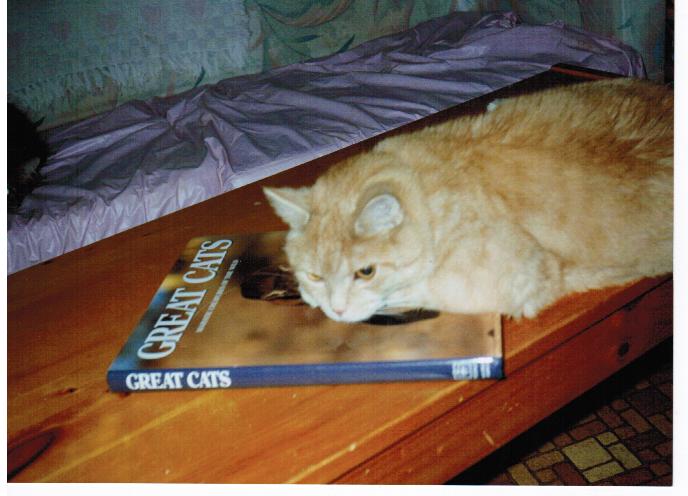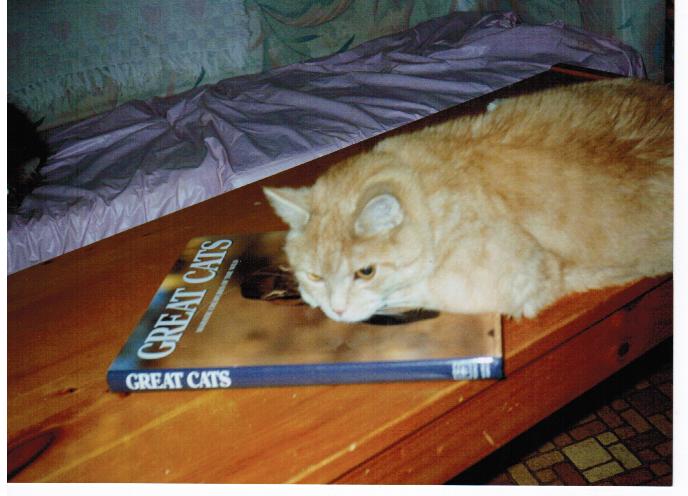
Sometimes A Good Purr Can Save Your Life!
Courtesy of: Dr. Gwen
My cat, Uri, wasn’t supposed to have a long life. Thankfully, he subscribed to the notion that cats have at least nine lives. He lived a happy 16 years but only because he managed to win the heart of a brand new veterinarian. Uri was going to be one of my first euthanasias but his charming purr turned him into a life-long feline friend and one of my first patients.
I had just been a vet for a few months in an emergency practice in Ottawa. It was late one Saturday night when Uri was brought into the emergency clinic by a young couple. He was about two years old, a pumpkin orange tabby with a large tomcat head and a purr that vibrated the table. He lay there purring to invite pats and attention. “What seems to be the trouble?” I asked the owners.
“Brandy (as he was called then) doesn’t want to eat,” the owners replied. I smiled at Brandy and said hello as I patted his head. His purr volume increased to rival a jack hammer. As the pats went from his head to the tail, I knew immediately what was wrong. Brandy was still a lean young cat with a muscular neck and chest that tapered into a narrow trim waist until my hand reached the large lump inside his belly.
I had learned early in vet school that cats with testicles can’t be pregnant so that left the most obvious diagnosis … a urinary obstruction. Male cats can develop crystals in their urine that clump together to block off their ability to urinate. A blockage was bad news. “Has he been vomiting?” I asked, hoping the answer was no. It turns out he had vomited a few times. This was a bad sign that suggested that the kidneys were feeling the intense pressure of the blockage. Death was knocking, calling Brandy’s name.
Sadly back in those days, cat foods were not what they are today. I knew that I could unblock Brandy’s bladder but frequently cats with this condition block again and the long term answer was to perform a surgery that involved amputating the kitty’s penis! Because of this, convincing pet owners to treat their blocked kitties was a difficult thing to do.
As I was a newly minted vet, I wasn’t yet skilled in communicating to people about their pet’s health. I wondered, “How do I tell them that penis amputation may be in their cat’s future?” Thank goodness that our knowledge of food has enabled us to manage urinary disease much better … I haven’t done a penis amputation in 20 years.
As Brandy lay on that table listening and purring, the conversation turned to tears for the pet owners. Being a young couple, pregnant with their first child, they couldn’t commit to the costs associated with saving Brandy’s life. Euthanasia seemed like the only humane answer.
“Euthanize!” I heard myself scream in my head, “but he is so sweet and purry, how can I do that to him?” In a split second I made up my mind. Brandy was not going to die that day or the next day or for at least ten years. I was going to make sure of that. I explained to the couple that this was my first time being faced with this decision and I found it hard to go through with it.
“Will you give him to me? I will look after him and give him a good home as long as I can,” I promised. Brandy’s watchful eyes looked at me with the purr humming in the background like he was a backup to my song. The couple happily agreed.
Brandy was pretty sick. Not only was he vomiting but his heart was slowing down, another bad sign. His electrolyte imbalances were affecting his heart and could possibly stop it. I had to act fast. Thankfully, the blockage was typically simple to dislodge. It doesn’t seem fair that such a small problem can cause death so quickly.
I nursed him back to health over the next few days and decided that the only body part I was going to take from him was his testicles. He didn’t seem to mind, his purr seemed more important to him then his gonads and it was alive and well.
Brandy didn’t seem like the right name for him. He seemed to me to be a lot more than a ‘Brandy’. Being still very keen on my new profession, I thought an anatomical name would suit him the best, something that would remind me of how our lives crossed paths. ‘Uri’ (short for urinary) seemed like the obvious choice to my recently-graduated-vet-mind.
After a 30 minute ride in my backpack on my bike I introduced Uri to my home. It took about two seconds for him to check the place out (it was pretty small) and say hello to my other cat, Mouth (another vet student bad name choice) and reboot his purr. That was when my boyfriend (now husband) looked at me like I had two heads. “Uri? What kind of name is that?” He was completely unimpressed with my choice. “He is not a Uri …. he is a Purry.”
From that day on, Uri-Purry enriched our lives and hearts for 14 more years.
There are a few more chapters to Uri’s life … stay tuned.


0 Comments